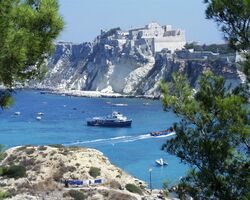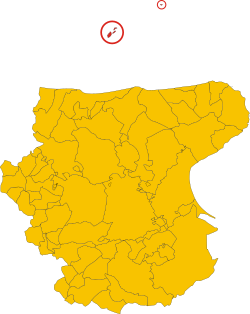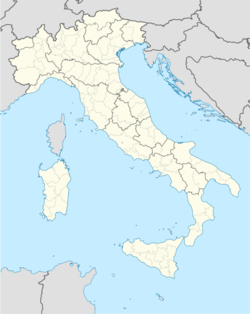جزر تريميتي
Tremiti Islands
Isole Tremiti | |
|---|---|
| Comune di Isole Tremiti | |
 A view of San Nicola island from the nearby San Domino island, with the Abbey of Santa Maria a Mare fortified complex. | |
 Tremiti within the Province of Foggia | |
| الإحداثيات: 42°07′N 15°30′E / 42.117°N 15.500°E | |
| البلد | إيطاليا |
| المنطقة | Apulia |
| المقاطعة | Foggia (FG) |
| Frazioni | Isola San Nicola, Isola San Domino |
| الحكومة | |
| • العمدة | Antonio Fentini |
| المساحة | |
| • الإجمالي | 3٫13 كم² (1٫21 ميل²) |
| المنسوب | 70 m (230 ft) |
| التعداد (May 2021) | |
| • الإجمالي | 454 |
| • الكثافة | 150/km2 (380/sq mi) |
| صفة المواطن | Tremitesi |
| منطقة التوقيت | UTC+1 (CET) |
| • الصيف (التوقيت الصيفي) | UTC+2 (CEST) |
| الرمز البريدي | 71051 |
| مفتاح الهاتف | 0882 |
| Patron saint | Our Lady of Assumption |
| يوم القديس | 15 August |
| الموقع الإلكتروني | Official website |
The Tremiti Islands (إيطالية: Isole Tremiti, النطق بالإيطالية: [ˈiːzole ˈtrɛːmiti]), also literarily known as Isole Diomedee ("Diomedean Islands", from Greek Διομήδεες Diomédees), are an archipelago in the Adriatic Sea, north of the Gargano Peninsula. They constitute a comune of Italy's Province of Foggia, Apulia and form part of the Gargano national park. The archipelago is composed of 5 islands: San Domino, San Nicola, Capraia, Cretaccio, and Pianosa.[1]
The islands were used for the internment of political prisoners during Benito Mussolini's Fascist regime.[2] But it was also the prison of Julia the Younger, the granddaughter of Augustus.
The islands are now an important tourist attraction because of the clear waters surrounding them. Up to 100,000 visitors come to the islands in the summer season.[3] Ferry services from the mainland operate from Termoli, Vieste, Rodi Garganico and Capoiale,[4] while Alidaunia offers flights from San Domino Heliport to Foggia and Vieste.[5]
اسم المكان
The origin of the name of the islands is uncertain. Some of the theories include:
- it may relate to the seismic hazard of the area, which has a long history of earthquakes (from Latin tremor)
- it may date back to the times of Augustus, who exiled his granddaughter Julia the Younger to one of these islands, and then named Trimerus in Latin, maybe from Greek Τρίμερος Trímeros, meaning "three places" or "three islands").
- it may be due to the three-peak hill on the main island described by the cleric Basilio Sereno in an epigram written to Celso Bishop of Vercelli[6]
الجزر
- San Domino is where most of the population resides. It is the most developed island for tourism and has the only sand beach in the archipelago.
- San Nicola is the site of a monastery where a monk named Nicolò was buried. Legend has it that every time someone tried to move his corpse off the island, a violent storm would break out, preventing navigation around the island.
- Capraia (or Capperaia) is deserted.
- Cretaccio is a large block of clay and thus uninhabited.
- Pianosa is a small, uninhabited island. Its maximum elevation is 15 متر (49 ft). Sometimes, during storms, the waves cover it.
التاريخ
Inhabited since late Iron Age times (4th-3rd centuries BC), the Tremiti Islands have been a place of confinement since ancient times. Roman emperor Augustus had his granddaughter Julia the Younger transferred here, where she died after 20 years. In the Middle Ages, the archipelago was ruled by the Abbey of Santa Maria a Mare ("Holy Mary on the Sea") at San Nicola island, apparently founded here in the 9th century by Benedictine monks from Montecassino.
In the 13th century, the abbey had gained its autonomy from the father monastery, and owned lands from the Biferno to Trani on the Apulian mainland. After an alleged period of moral decadence, in 1237 the Benedictines were replaced by the Cistercian order. In 1334 the abbey was sacked by Dalmatian pirates from Omiš.
In 1412 the Lateran Canons took ownership of the islands and restored the abbey with cisterns and fortifications which withstood the assault of Ottoman ships in 1567. The abbey was suppressed in 1783 by King Ferdinand IV of Naples, who set up a penal colony.
During the Napoleonic age the islands were a stronghold of Joachim Murat's supporters, who resisted a British fleet in 1809. In 1843, to repopulate the islands, King Ferdinand II of Two Sicilies moved a number of people from Naples' slums to the islands, who mostly became fishermen.
In 1911, about 1,300 Libyans who had resisted Italian colonial rule were confined to Tremiti. After a year, around one-third of them had died, mainly from typhus.
1930s
During the Fascist era, the archipelago continued to perform its function of confinement, detaining, among others, Amerigo Dumini, and future president of the Republic, Sandro Pertini.
Mussolini had hundreds of homosexuals deported to San Domino, in 1938. No law prohibited homosexuality at the time, and Mussolini also denied its existence, saying, "In Italy, there are only real men".[بحاجة لمصدر] However, suspected or reported homosexuals were rounded up and deported. San Domino had the distinction of being the only internment camp in which all the prisoners were gay.[7] The conditions on the island were very difficult, and a few died.[8]
The dormitories were spartan, with no electricity or running water.[7] A bell would ring at 8 p.m. each day, signaling that the men were no longer allowed to be outside. For the remainder of the night, they were locked in their dorm rooms, under police supervision.[7]
The internment camp closed in 1939, as Italy became enmeshed in the beginnings of World War II.[7]
2010s
In May 2012, the provincial government caused a scandal by attempting to sell off blocks of land on two of the islands for development for a reported €4m. Local environmental groups campaigned vigorously and in the event, there were no bidders.[9]
انظر أيضاً
Sources
- Mancini, Enzo (1979). Isole Tremiti, sassi di Diomede: natura, storia, arte, turismo. Milan: Mursia.
References
- ^ "Isole Tremiti". Isole Tremiti. Retrieved 20 أكتوبر 2021.
- ^ Johnston, Alan (13 يونيو 2013). "A gay island community created by Italy's Fascists" (in الإنجليزية البريطانية). BBC News. Retrieved 19 مارس 2017.
- ^ Lonely Planet http://www.lonelyplanet.com/italy/puglia/isole-tremiti
- ^ Staniscia pio luigi (24 يوليو 2007). "TREMITI ISLANDS – Ferry schedule". Lecinqueisole.it. Retrieved 26 مارس 2013.
- ^ "Home Page". Alidaunia s.r.l. – Società di navigazione aerea (in الإيطالية). Retrieved 19 مارس 2017.
- ^ Cochorella, Benedicto (1998). Radicchio, Giuseppe (ed.). Descrizione accuratissima delle Isole Tremiti un tempo Isole Diomedee. Translated by Buonanome, Anna Maria. Palomar. p. 25.
- ^ أ ب ت ث Johnston, Alan. (12 June 2013). A gay island community created by Italy's Fascists. BBC News: retrieved 6/13/2013.
- ^ World Fascism, a historical encyclopedia, volume 1.
- ^ Squires, Nick (5 يونيو 2012). "Italian austerity forces region to sell its rare mouflon sheep". The Daily Telegraph. London. Retrieved 12 مايو 2013.
External links
- Tremiti Islands. How to get there, plan a day trip, excursion with kids
- Collecting landraces and wild relatives in the Tremiti Islands (FAO)[dead link]
- Isole Tremiti
- Pages using gadget WikiMiniAtlas
- CS1 الإنجليزية البريطانية-language sources (en-gb)
- CS1 الإيطالية-language sources (it)
- Use dmy dates from November 2022
- Short description is different from Wikidata
- Articles containing إيطالية-language text
- Coordinates on Wikidata
- Italian commune articles with missing parameters
- Pages using infobox Italian comune with unknown parameters
- Pages using Lang-xx templates
- Articles containing Ancient Greek (to 1453)-language text
- Articles containing لاتينية-language text
- Articles with unsourced statements from May 2022
- Articles with dead external links from November 2017
- Pages with empty portal template
- مدن وبلدات في أپوليا
- بلديات مقاطعة فودجا
- Islands of the Adriatic Sea
- Defunct prisons in Italy
- Islands of Apulia
- Archipelagoes of Italy
- صفحات مع الخرائط



